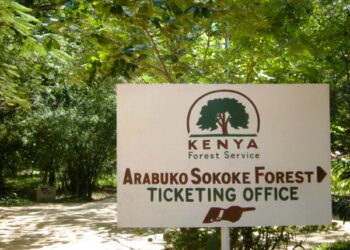In Kenya’s Mount Kenya region, Embu and Meru counties have emerged as the epicentre of muguka production, a potent variety of khat (Catha edulis) that has taken the luxury market by storm.
Muguka, known for its psychoactive properties and affordability compared to its counterpart miraa, has transformed the economic landscape of these agrarian counties, generating billions in revenue and sparking both opportunity and controversy.
As muguka’s popularity surges in urban centers like Nairobi and Mombasa, its impact on local economies, cultural practices, and public health debates has drawn global attention.
Let us explores the rise of muguka, its cultivation in Embu and Meru, its dominance in the luxury market, and the challenges it faces amid calls for regulation.
Muguka: The Green Gold of Embu and Meru Counties
Muguka, a low-cost, highly addictive stimulant consisting solely of khat leaves, is predominantly grown in the semi-arid lowlands of Embu’s Mbeere North and Mbeere South sub-counties and parts of Meru, particularly along the Nyambene Hills.
Embu County, with an estimated 65,000 farmers cultivating muguka, has positioned the crop as a top income earner, rivaling tea and coffee. Meru, traditionally known for miraa (which includes both stems and leaves), has also seen a shift toward muguka production due to its higher demand and faster harvest cycles.
According to the Embu County agriculture docket, muguka contributes approximately Ksh 22 billion annually to the local economy, with daily deliveries of 36,000 kilograms to Mombasa alone generating Ksh 10.8 million for farmers.
Embu County, located between latitude 0° 8’ and 0° 50’ South and longitude 37° 3’ and 37° 9’ East, spans 2,821 km² and is home to the Embu, Mbeere, and Kamba ethnic communities.
Its semi-arid Mbeere region, reliant on seasonal rivers, has turned to muguka as a resilient crop suited to the dry climate. Meru County, bordering Embu to the northwest, boasts fertile soils along the Nyambene Hills, where muguka and miraa thrive.
The region’s agricultural focus, with 70.1% of Embu’s population engaged in farming, has made muguka a lifeline for thousands of households.
Muguka’s Rise in the Luxury Market
Muguka’s appeal in the luxury market stems from its affordability, potency, and cultural significance.
Unlike miraa, which sells for Ksh 500–1,000 per bag, muguka is available for as low as Ksh 20, making it accessible to a broad demographic, including urban youth and professionals seeking a quick euphoric high.
Its compact leaves deliver a stronger dose of cathinone and cathine, psychoactive compounds that produce alertness and enhanced mood, often consumed in social settings or during late-night work sessions.
This has positioned muguka as a “luxury” stimulant in urban centers, where it is marketed as a trendy alternative to alcohol or cannabis.
In Nairobi’s upscale clubs and Mombasa’s coastal markets, muguka is often packaged in sleek, branded bundles, appealing to a younger, image-conscious clientele.
Traders have capitalized on its low cost and high demand, with makeshift kiosks and delivery services catering to consumers. Social media platforms like TikTok and Instagram have further amplified muguka’s allure, with influencers showcasing its use in vibrant nightlife scenes.
The luxury market’s embrace of muguka has also spurred innovation. Researchers at Meru University have developed value-added products like Muguka Energy Drink and Miraa Bamboocha wine, targeting consumers who prefer processed alternatives to raw leaves.
These products, showcased at trade exhibitions, aim to destigmatize muguka and expand its market reach. However, regulatory hurdles, such as the Narcotic Drugs and Psychotropic Substances Control Act, have limited certification by the Kenya Bureau of Standards (KEBS), slowing commercial rollout.
Muguka’s Economic Impact
Muguka’s economic impact on Embu and Meru is profound. In Embu, the government has invested over Ksh 60 million to support farmers, including Sh 53 million in soft loans for inputs like fertilizers and irrigation systems. The crop has transformed lives in Mbeere, where farmers once relied on subsistence crops like maize and beans.
“Muguka has enabled residents to educate their children and buy food,” said Mbeere South deputy county commissioner Charles Igiha, highlighting its role as an economic backbone.
In Meru, muguka and miraa exports to Somalia generate Ksh 4 billion annually, though competition from cheaper Ethiopian khat has squeezed profits.
Despite its economic benefits, muguka faces significant challenges. Coastal counties like Mombasa and Kilifi attempted to ban its sale in May 2024, citing health concerns, particularly among youth.
The National Authority for the Campaign Against Drug Abuse (NACADA) classifies muguka as a drug due to its cathinone and cathine content, linking it to dehydration, dental decay, insomnia, and dependence. Coastal leaders reported a 31.4% usage rate among Mombasa residents aged 19–44, with claims of increased school dropouts and mental health issues.
The ban, overturned by President William Ruto and the Embu High Court, sparked a regional trade dispute, with Embu Governor Cecily Mbarire defending the Ksh 22 billion industry.
Price fluctuations also threaten farmers. In 2021, muguka prices in Embu dropped from Ksh 1,000 to Ksh 100 per kilogram due to oversupply during rainy seasons and competition from Kirinyaga farmers with better water access.
Farmers like Wilkister Njeri lamented the glut, calling for government support in securing export markets. The Agriculture Ministry has responded with initiatives like earth dams and boreholes in Mbeere to boost production, but cartels and unfair trade practices continue to depress prices.
Muguka’s Cultural and Social Dynamics
Muguka holds cultural significance, particularly among the Meru, where it plays a role in marriage ceremonies and social gatherings. Its affordability has made it a staple in urban subcultures, but this has fueled tensions with authorities.
Coastal religious leaders and governors argue that muguka’s accessibility to schoolchildren exacerbates addiction and mental health issues, prompting calls for stricter regulations.
In contrast, Embu and Meru leaders view it as a legitimate cash crop, with Deputy Governor Kinyua Mugo arguing there is “no scientific evidence” to classify muguka as a drug.
The rivalry between muguka and miraa has also created friction. Embu traders in 2019 banned Meru miraa sellers from local markets, accusing them of undercutting prices with lower-quality leaves.
This led to violence at Embu’s Kamuketha market, highlighting the economic stakes. Nyambene Miraa Traders Association chairman Kimathi Munjuri has pushed for muguka to be gazetted separately from miraa, arguing that conflating the two harms Meru’s premium market.
Muguka’s Future Prospects
Muguka’s dominance in the luxury market hinges on balancing economic benefits with public health concerns. The Crop Act 2013 and Miraa Regulations 2022 recognize muguka as a scheduled crop, obligating government support for its farming and export.
However, the Narcotic Drugs and Psychotropic Substances Control Act lists cathinone and cathine as controlled substances, creating legal ambiguity. The Katiba Institute notes that counties lack authority to ban muguka outright, as criminal law falls under national jurisdiction.
Efforts to regulate muguka include a joint committee formed by Mombasa and Embu governors to address trade and consumption issues. Meanwhile, Meru University’s research into value-added products like chewing gum and infusion bags could open new luxury markets, provided regulatory barriers are lifted.
Farmers and traders continue to advocate for government intervention to stabilise prices and expand exports to countries like Djibouti and Ethiopia, where khat is widely consumed.
As Kenya navigates this complex landscape, muguka’s role in Embu and Meru counties remains a testament to the region’s agricultural resilience. Its rise in the luxury market reflects changing consumer trends, but ongoing debates over health impacts and regulation will shape its future.















